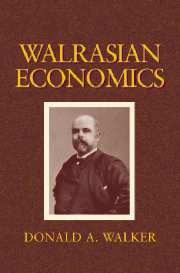Book contents
- Frontmatter
- Contents
- Preface
- Introduction
- Part I Walras's ideas
- Part II Walras's influence
- 9 Models constructed by Walras's contemporaries and immediate successors
- 10 Models drawing upon the heritage of the written pledges sketch, 1930 to 1971
- 11 Concluding comments: Walras's ideas in modern economics
- References
- References and Bibliography for Chapter 11
- Index
11 - Concluding comments: Walras's ideas in modern economics
Published online by Cambridge University Press: 02 September 2009
- Frontmatter
- Contents
- Preface
- Introduction
- Part I Walras's ideas
- Part II Walras's influence
- 9 Models constructed by Walras's contemporaries and immediate successors
- 10 Models drawing upon the heritage of the written pledges sketch, 1930 to 1971
- 11 Concluding comments: Walras's ideas in modern economics
- References
- References and Bibliography for Chapter 11
- Index
Summary
This book has told the story thus far of the past influence of Walras's mature comprehensive model and his written pledges sketch. The latter gave rise to the virtual line of general equilibrium research that dominated the agenda of economists working in that field for more than forty years in the twentieth century, and aspects of that line of research continue to be pursued in some modern theorizing. The constructions and functioning of the mature comprehensive model have a secure place in the history of general equilibrium modeling as providing its beginning and as furnishing ideas that have been used throughout its history. In that model, Walras developed a non-virtual model in which economic decisions are made in private markets by entrepreneurs, suppliers of economic resources, consumers, and savers, and in which the markets are purely competitive. It has four major characteristics. First, the markets in it are interrelated, so the values of the economic variables are mutually determined and the impact of a change in a parameter is manifested throughout the economic system. Second, irrevocable transactions, production, consumption, savings, and investment occur in disequilibrium. Third, when the economy is in disequilibrium it moves toward an equilibrium position. Fourth, that position is on a path of growth. The position changes as the economy grows, or possibly contracts, tracing out a path through time.
- Type
- Chapter
- Information
- Walrasian Economics , pp. 313 - 316Publisher: Cambridge University PressPrint publication year: 2006



